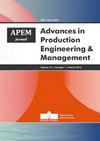基于抛物线通道的仓库内部布局设计方法
IF 2.8
3区 工程技术
Q2 ENGINEERING, MANUFACTURING
引用次数: 4
摘要
精细化布局是仓储效率的基础。直通道是当前仓库内部布局的典型特征。本文的目的是探讨在仓库布局中使用曲线通道的可能性。通过选择典型的非传统布局,将其倾斜的跨通道轨迹转化为抛物线,构造了抛物线式Flying-V和抛物线式Fishbone两种抛物线式通道布局。对于单位负荷仓库,在形态特征分析和抛物线型选择的基础上,提出了拣货距离模型和跨通道长度公式。分别采用区间数值模拟方法(INSM)和遗传算法(GA)对模型进行求解,验证结果。本研究突破了直通道超前仓库布局的现实情况,丰富了相关布局理论。对100个不同规模的仓库进行了计算,结果表明,抛物线飞- v的拣货距离比直线布局可缩短0.22 ~ 0.62%,理论可能的改进空间压缩了2.42 ~ 12.26%。其跨通道长度缩短-0.03- 3.10%。抛物面鱼骨的采收距离仅缩短0.02 ~ 0.04%。理论上可能的改进空间被压缩了1.27- 1.83%。但其跨通道长度将显著增加4.63% ~ 19.50%。认为基于曲线轨迹通道的非矩形复杂异形仓库布局将成为一个重要的研究课题。此外,本文提出的方法在对目标和约束条件进行必要的修改后,原则上也可用于车间内机器设备的布置。本文章由计算机程序翻译,如有差异,请以英文原文为准。
Designing a warehouse internal layout using a parabolic aisles based method
Refined layout is a basis of warehousing efficiency. Straight aisle is a typical feature of current warehouse internal layouts. The purpose of this paper is to explore the possibility of using curve aisles for warehouse layout. By Choosing typical non-traditional layouts and transforming their inclined cross-aisle trajectory into parabola, two parabolic aisle layouts, parabolic Flying-V and parabolic Fishbone, are constructed. For unit-load warehouses, based on the morphological characteristic analysis and the parabolic types selection, the picking distance model and the cross-aisle length formula are presented. Interval Numerical Simulation Method (INSM) and Genetic Algorithms (GA) are adopted to solve the model respectively in order to verify the results. This research breaks through the realistic situation of straight aisle leading warehouse layout, and enriches the relevant layout theory. The calculation results of 100 warehouses with different sizes show that the picking distance of parabolic Flying-V could be reduced by 0.22-0.62 % compared with the straight layout, and the theoretical possible improvement space has been compressed by 2.42-12.26 %. Its length of cross-aisle is shortened by -0.03-3.10 %. The picking distance of parabolic Fishbone could be only reduced by 0.02-0.04 %. The theoretical possible improvement space has been compressed by 1.27-1.83 %. But its length of cross-aisle will increase by 4.63-19.50 % significantly. We believe that the layout of non-rectangular complex special-shaped warehouses based on curve trajectory aisles would become an important research topic. In addition, after some necessary modifications to the objectives and constraints, the proposed method in this paper may also be used for the arrangement of machines and devices in a workshop in principle.
求助全文
通过发布文献求助,成功后即可免费获取论文全文。
去求助
来源期刊

Advances in Production Engineering & Management
ENGINEERING, MANUFACTURINGMATERIALS SCIENC-MATERIALS SCIENCE, MULTIDISCIPLINARY
CiteScore
5.90
自引率
22.20%
发文量
19
期刊介绍:
Advances in Production Engineering & Management (APEM journal) is an interdisciplinary international academic journal published quarterly. The main goal of the APEM journal is to present original, high quality, theoretical and application-oriented research developments in all areas of production engineering and production management to a broad audience of academics and practitioners. In order to bridge the gap between theory and practice, applications based on advanced theory and case studies are particularly welcome. For theoretical papers, their originality and research contributions are the main factors in the evaluation process. General approaches, formalisms, algorithms or techniques should be illustrated with significant applications that demonstrate their applicability to real-world problems. Please note the APEM journal is not intended especially for studying problems in the finance, economics, business, and bank sectors even though the methodology in the paper is quality/project management oriented. Therefore, the papers should include a substantial level of engineering issues in the field of manufacturing engineering.
 求助内容:
求助内容: 应助结果提醒方式:
应助结果提醒方式:


